DODGE NITRO 2010 1.G Owner's Guide
Manufacturer: DODGE, Model Year: 2010, Model line: NITRO, Model: DODGE NITRO 2010 1.GPages: 498, PDF Size: 6.94 MB
Page 31 of 498
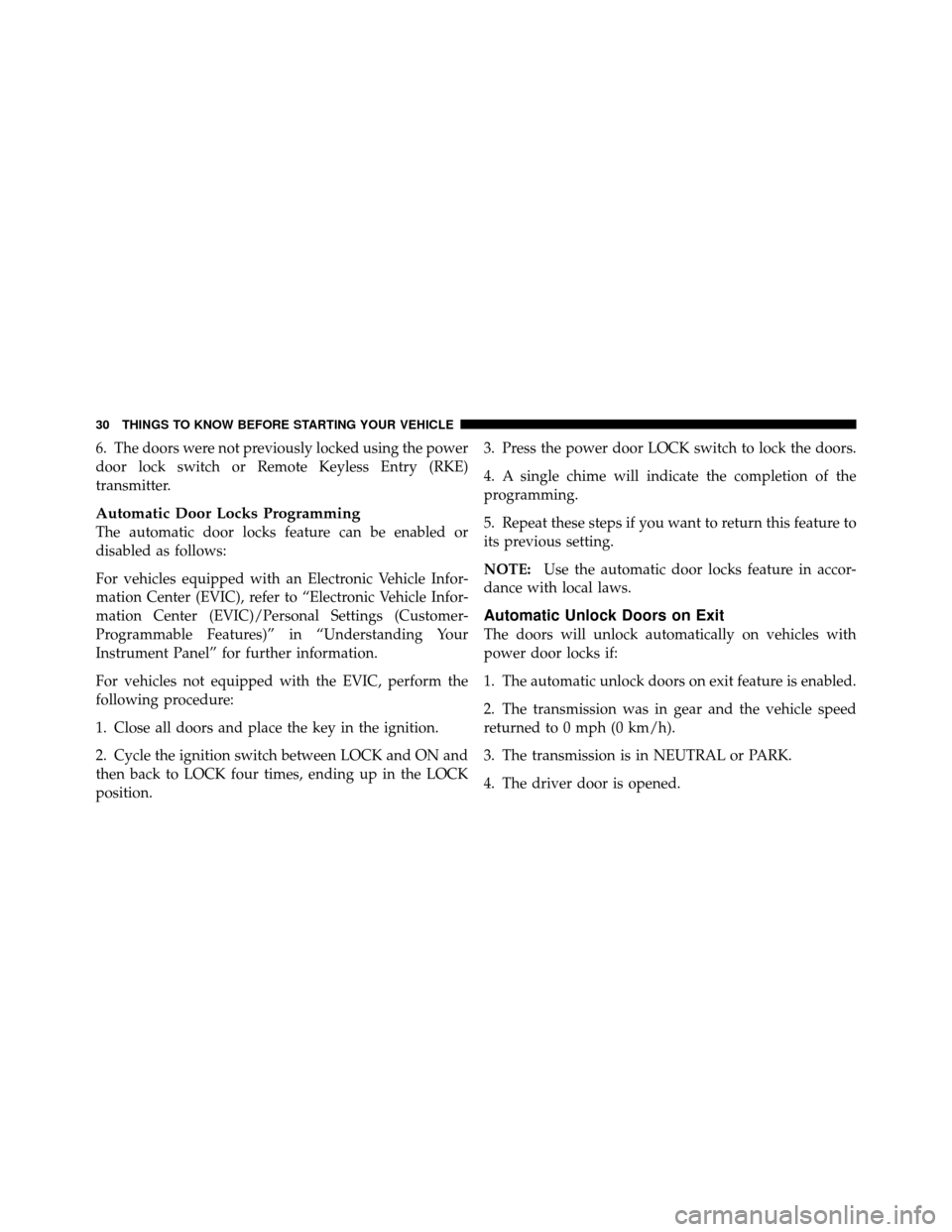
6. The doors were not previously locked using the power
door lock switch or Remote Keyless Entry (RKE)
transmitter.
Automatic Door Locks Programming
The automatic door locks feature can be enabled or
disabled as follows:
For vehicles equipped with an Electronic Vehicle Infor-
mation Center (EVIC), refer to “Electronic Vehicle Infor-
mation Center (EVIC)/Personal Settings (Customer-
Programmable Features)” in “Understanding Your
Instrument Panel” for further information.
For vehicles not equipped with the EVIC, perform the
following procedure:
1. Close all doors and place the key in the ignition.
2. Cycle the ignition switch between LOCK and ON and
then back to LOCK four times, ending up in the LOCK
position.3. Press the power door LOCK switch to lock the doors.
4. A single chime will indicate the completion of the
programming.
5. Repeat these steps if you want to return this feature to
its previous setting.
NOTE:
Use the automatic door locks feature in accor-
dance with local laws.
Automatic Unlock Doors on Exit
The doors will unlock automatically on vehicles with
power door locks if:
1. The automatic unlock doors on exit feature is enabled.
2. The transmission was in gear and the vehicle speed
returned to 0 mph (0 km/h).
3. The transmission is in NEUTRAL or PARK.
4. The driver door is opened.
30 THINGS TO KNOW BEFORE STARTING YOUR VEHICLE
Page 32 of 498
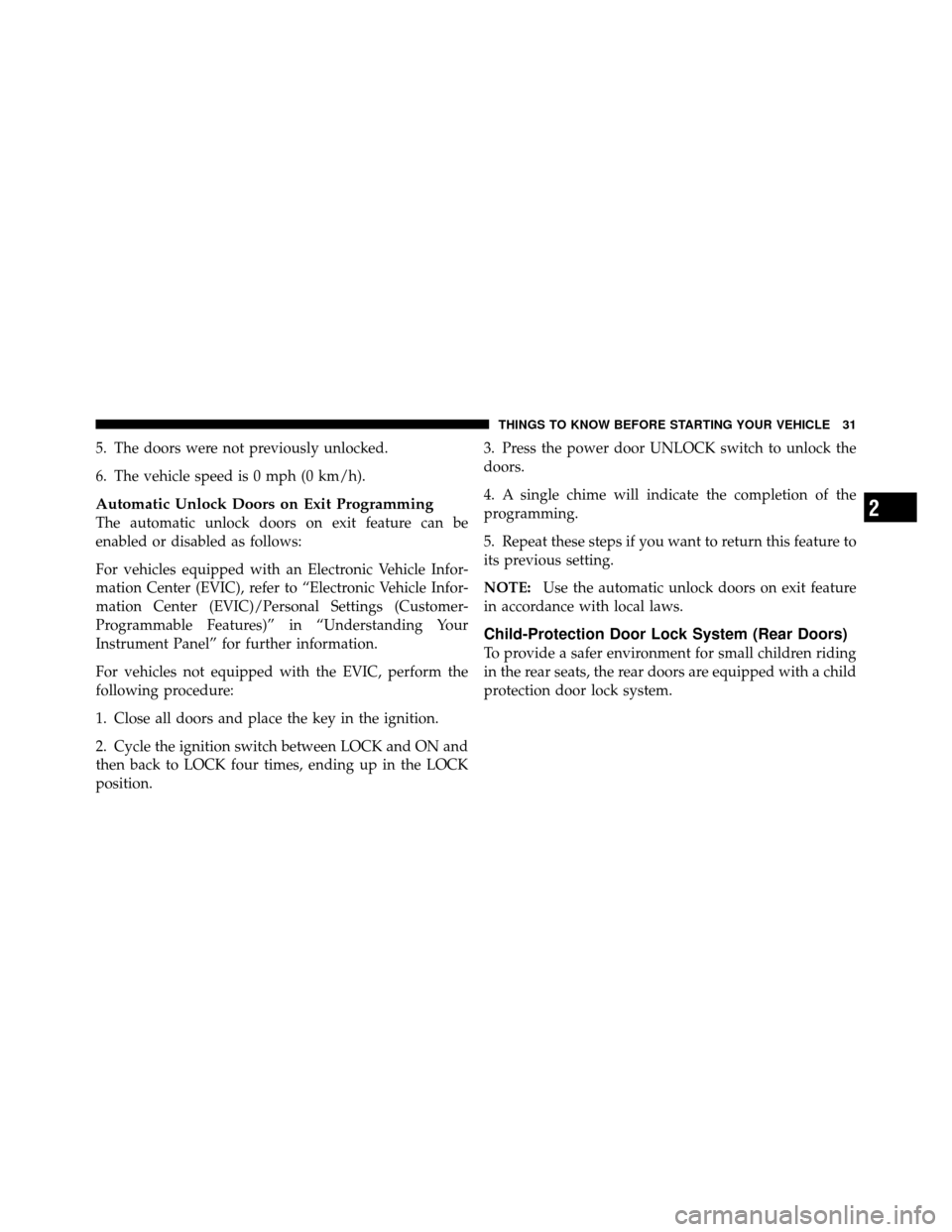
5. The doors were not previously unlocked.
6. The vehicle speed is 0 mph (0 km/h).
Automatic Unlock Doors on Exit Programming
The automatic unlock doors on exit feature can be
enabled or disabled as follows:
For vehicles equipped with an Electronic Vehicle Infor-
mation Center (EVIC), refer to “Electronic Vehicle Infor-
mation Center (EVIC)/Personal Settings (Customer-
Programmable Features)” in “Understanding Your
Instrument Panel” for further information.
For vehicles not equipped with the EVIC, perform the
following procedure:
1. Close all doors and place the key in the ignition.
2. Cycle the ignition switch between LOCK and ON and
then back to LOCK four times, ending up in the LOCK
position.3. Press the power door UNLOCK switch to unlock the
doors.
4. A single chime will indicate the completion of the
programming.
5. Repeat these steps if you want to return this feature to
its previous setting.
NOTE:
Use the automatic unlock doors on exit feature
in accordance with local laws.
Child-Protection Door Lock System (Rear Doors)
To provide a safer environment for small children riding
in the rear seats, the rear doors are equipped with a child
protection door lock system.
2
THINGS TO KNOW BEFORE STARTING YOUR VEHICLE 31
Page 33 of 498
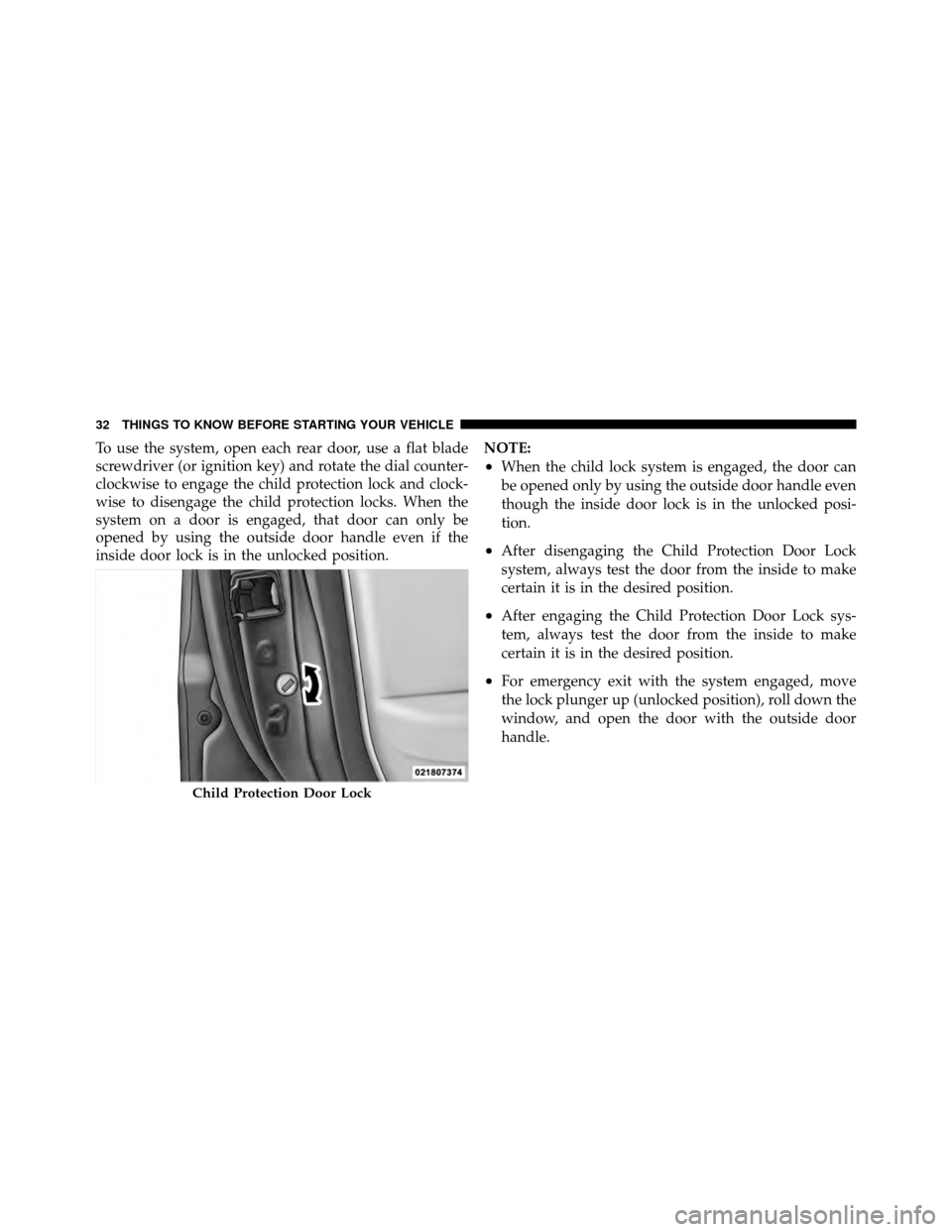
To use the system, open each rear door, use a flat blade
screwdriver (or ignition key) and rotate the dial counter-
clockwise to engage the child protection lock and clock-
wise to disengage the child protection locks. When the
system on a door is engaged, that door can only be
opened by using the outside door handle even if the
inside door lock is in the unlocked position.NOTE:
•When the child lock system is engaged, the door can
be opened only by using the outside door handle even
though the inside door lock is in the unlocked posi-
tion.
•After disengaging the Child Protection Door Lock
system, always test the door from the inside to make
certain it is in the desired position.
•After engaging the Child Protection Door Lock sys-
tem, always test the door from the inside to make
certain it is in the desired position.
•For emergency exit with the system engaged, move
the lock plunger up (unlocked position), roll down the
window, and open the door with the outside door
handle.
Child Protection Door Lock
32 THINGS TO KNOW BEFORE STARTING YOUR VEHICLE
Page 34 of 498
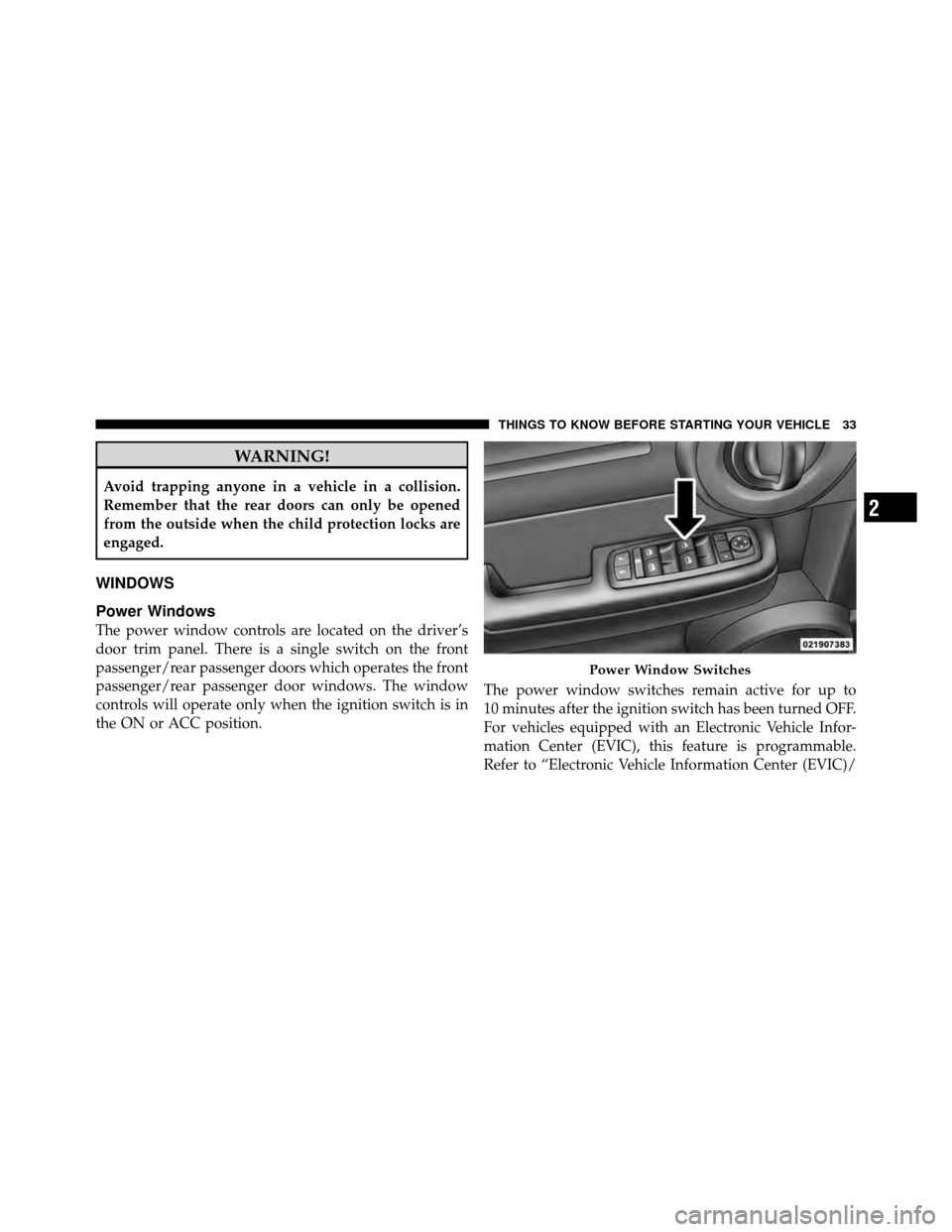
WARNING!
Avoid trapping anyone in a vehicle in a collision.
Remember that the rear doors can only be opened
from the outside when the child protection locks are
engaged.
WINDOWS
Power Windows
The power window controls are located on the driver’s
door trim panel. There is a single switch on the front
passenger/rear passenger doors which operates the front
passenger/rear passenger door windows. The window
controls will operate only when the ignition switch is in
the ON or ACC position.The power window switches remain active for up to
10 minutes after the ignition switch has been turned OFF.
For vehicles equipped with an Electronic Vehicle Infor-
mation Center (EVIC), this feature is programmable.
Refer to “Electronic Vehicle Information Center (EVIC)/
Power Window Switches
2
THINGS TO KNOW BEFORE STARTING YOUR VEHICLE 33
Page 35 of 498
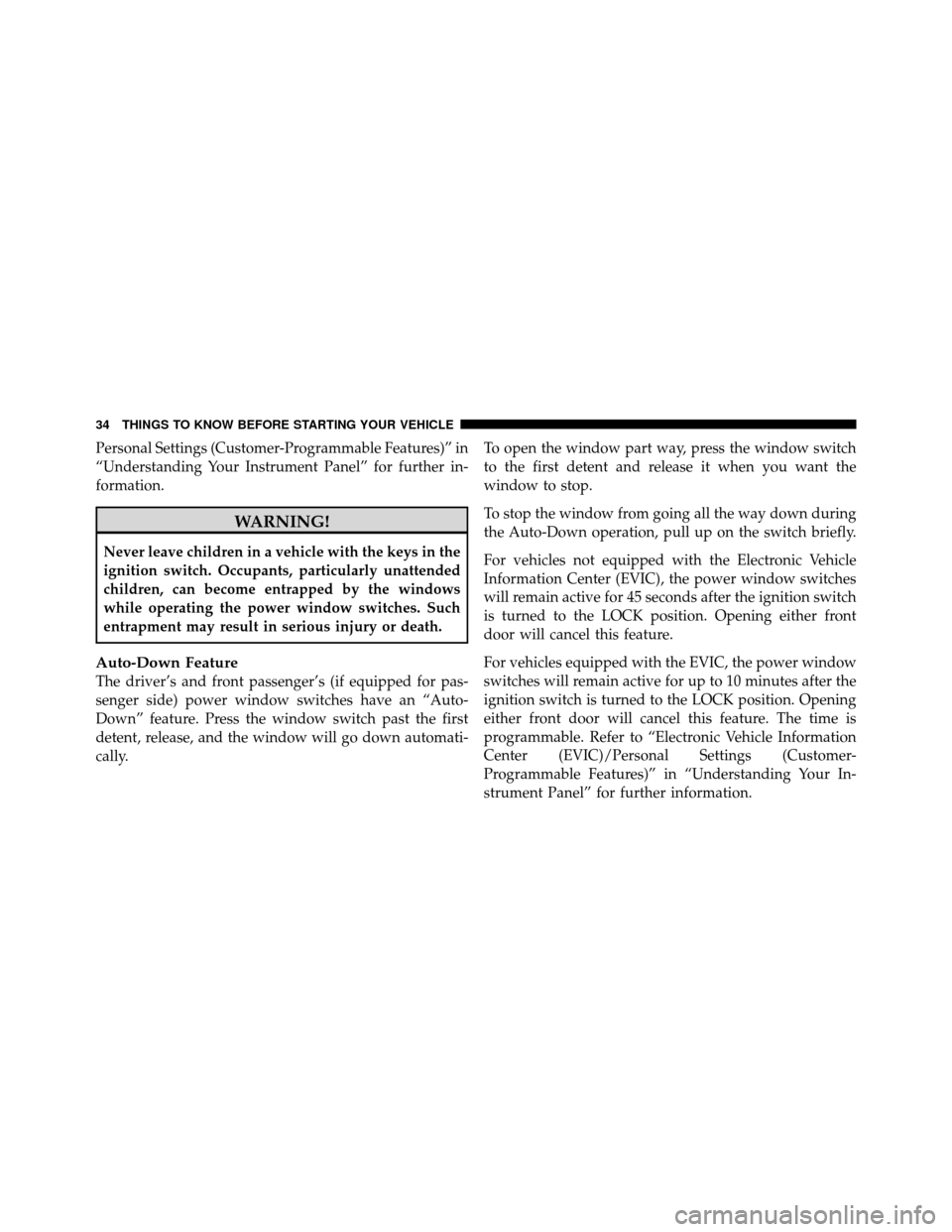
Personal Settings (Customer-Programmable Features)” in
“Understanding Your Instrument Panel” for further in-
formation.
WARNING!
Never leave children in a vehicle with the keys in the
ignition switch. Occupants, particularly unattended
children, can become entrapped by the windows
while operating the power window switches. Such
entrapment may result in serious injury or death.
Auto-Down Feature
The driver’s and front passenger’s (if equipped for pas-
senger side) power window switches have an “Auto-
Down” feature. Press the window switch past the first
detent, release, and the window will go down automati-
cally.To open the window part way, press the window switch
to the first detent and release it when you want the
window to stop.
To stop the window from going all the way down during
the Auto-Down operation, pull up on the switch briefly.
For vehicles not equipped with the Electronic Vehicle
Information Center (EVIC), the power window switches
will remain active for 45 seconds after the ignition switch
is turned to the LOCK position. Opening either front
door will cancel this feature.
For vehicles equipped with the EVIC, the power window
switches will remain active for up to 10 minutes after the
ignition switch is turned to the LOCK position. Opening
either front door will cancel this feature. The time is
programmable. Refer to “Electronic Vehicle Information
Center (EVIC)/Personal Settings (Customer-
Programmable Features)” in “Understanding Your In-
strument Panel” for further information.
34 THINGS TO KNOW BEFORE STARTING YOUR VEHICLE
Page 36 of 498
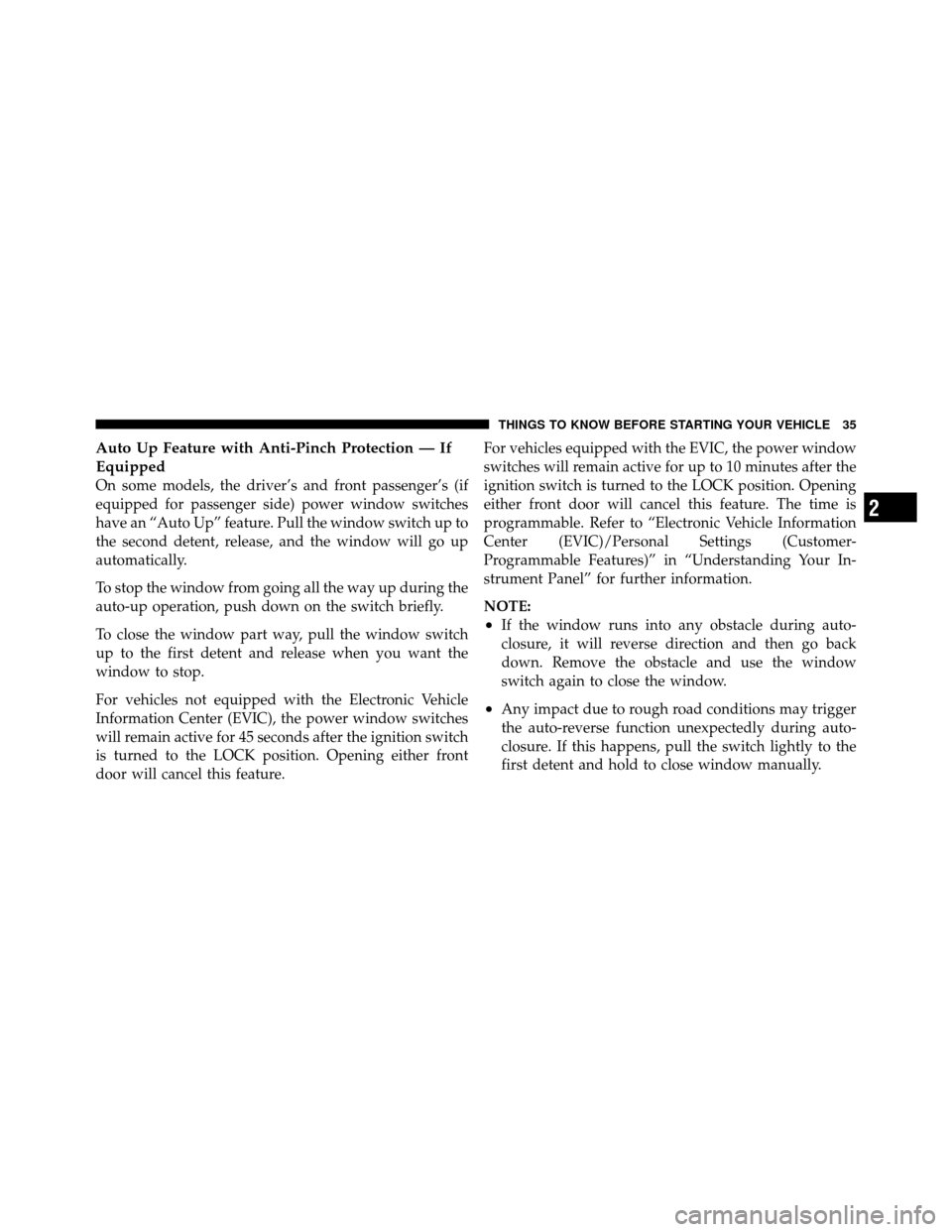
Auto Up Feature with Anti-Pinch Protection — If
Equipped
On some models, the driver’s and front passenger’s (if
equipped for passenger side) power window switches
have an “Auto Up” feature. Pull the window switch up to
the second detent, release, and the window will go up
automatically.
To stop the window from going all the way up during the
auto-up operation, push down on the switch briefly.
To close the window part way, pull the window switch
up to the first detent and release when you want the
window to stop.
For vehicles not equipped with the Electronic Vehicle
Information Center (EVIC), the power window switches
will remain active for 45 seconds after the ignition switch
is turned to the LOCK position. Opening either front
door will cancel this feature.For vehicles equipped with the EVIC, the power window
switches will remain active for up to 10 minutes after the
ignition switch is turned to the LOCK position. Opening
either front door will cancel this feature. The time is
programmable. Refer to “Electronic Vehicle Information
Center (EVIC)/Personal Settings (Customer-
Programmable Features)” in “Understanding Your In-
strument Panel” for further information.
NOTE:
•If the window runs into any obstacle during auto-
closure, it will reverse direction and then go back
down. Remove the obstacle and use the window
switch again to close the window.
•Any impact due to rough road conditions may trigger
the auto-reverse function unexpectedly during auto-
closure. If this happens, pull the switch lightly to the
first detent and hold to close window manually.
2
THINGS TO KNOW BEFORE STARTING YOUR VEHICLE 35
Page 37 of 498
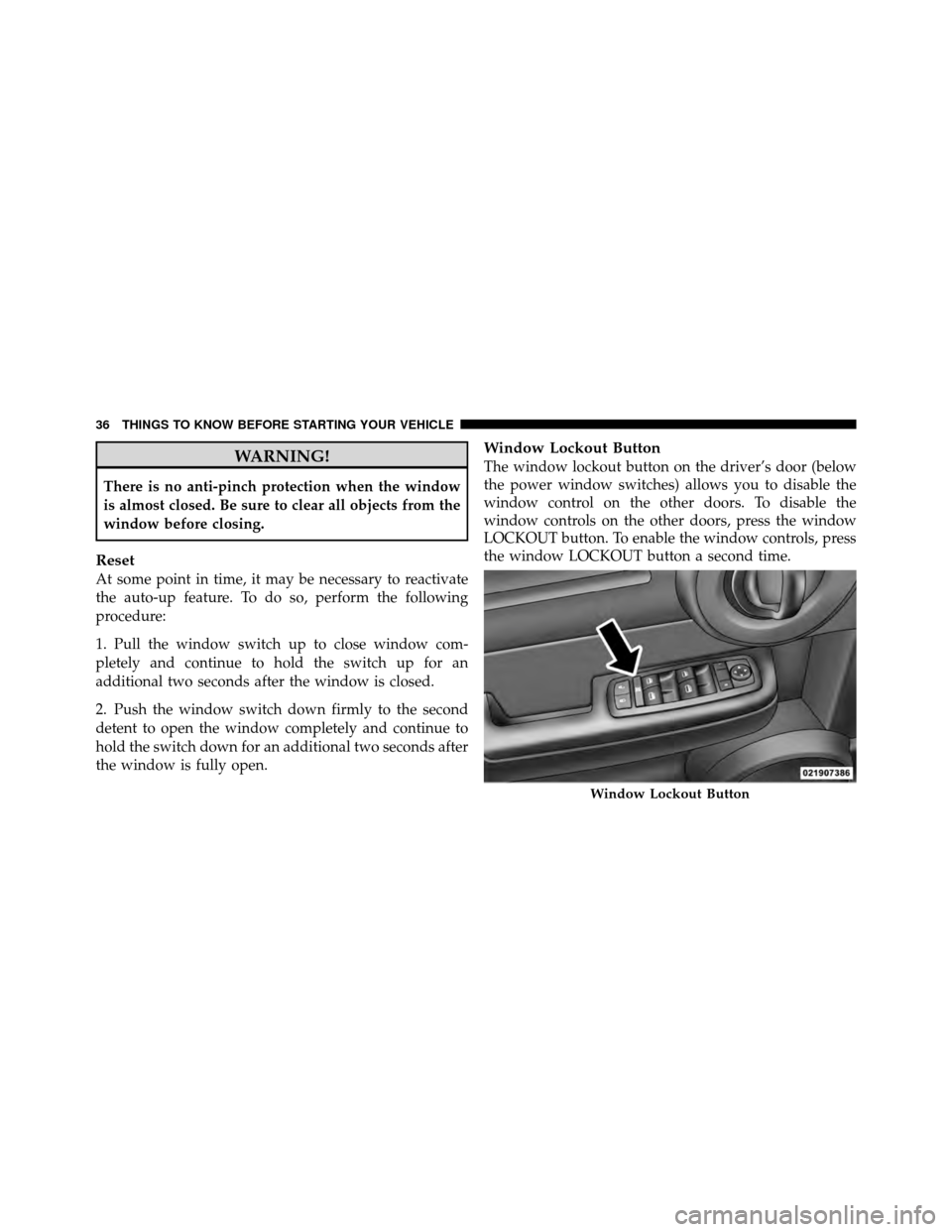
WARNING!
There is no anti-pinch protection when the window
is almost closed. Be sure to clear all objects from the
window before closing.
Reset
At some point in time, it may be necessary to reactivate
the auto-up feature. To do so, perform the following
procedure:
1. Pull the window switch up to close window com-
pletely and continue to hold the switch up for an
additional two seconds after the window is closed.
2. Push the window switch down firmly to the second
detent to open the window completely and continue to
hold the switch down for an additional two seconds after
the window is fully open.
Window Lockout Button
The window lockout button on the driver’s door (below
the power window switches) allows you to disable the
window control on the other doors. To disable the
window controls on the other doors, press the window
LOCKOUT button. To enable the window controls, press
the window LOCKOUT button a second time.
Window Lockout Button
36 THINGS TO KNOW BEFORE STARTING YOUR VEHICLE
Page 38 of 498
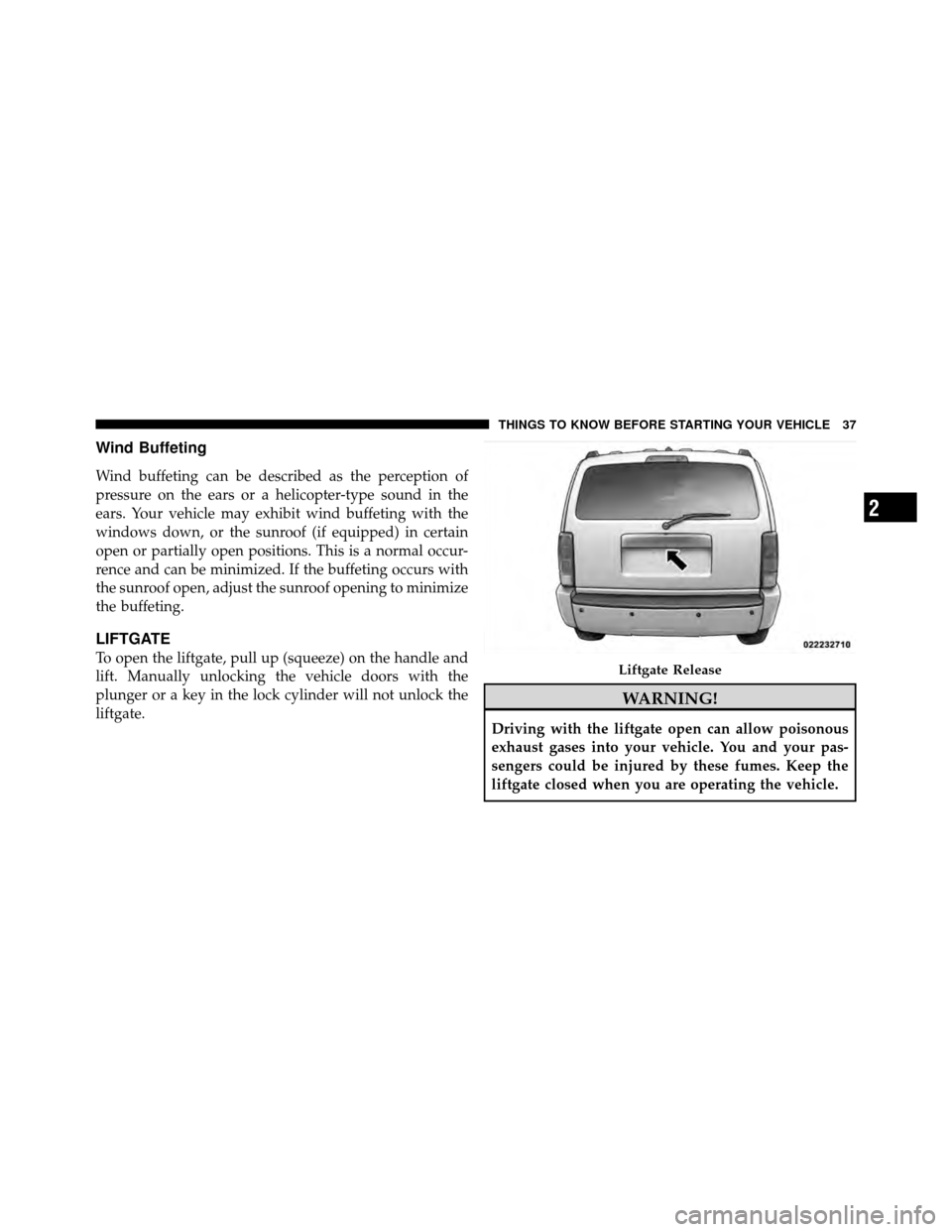
Wind Buffeting
Wind buffeting can be described as the perception of
pressure on the ears or a helicopter-type sound in the
ears. Your vehicle may exhibit wind buffeting with the
windows down, or the sunroof (if equipped) in certain
open or partially open positions. This is a normal occur-
rence and can be minimized. If the buffeting occurs with
the sunroof open, adjust the sunroof opening to minimize
the buffeting.
LIFTGATE
To open the liftgate, pull up (squeeze) on the handle and
lift. Manually unlocking the vehicle doors with the
plunger or a key in the lock cylinder will not unlock the
liftgate.
WARNING!
Driving with the liftgate open can allow poisonous
exhaust gases into your vehicle. You and your pas-
sengers could be injured by these fumes. Keep the
liftgate closed when you are operating the vehicle.
Liftgate Release
2
THINGS TO KNOW BEFORE STARTING YOUR VEHICLE 37
Page 39 of 498
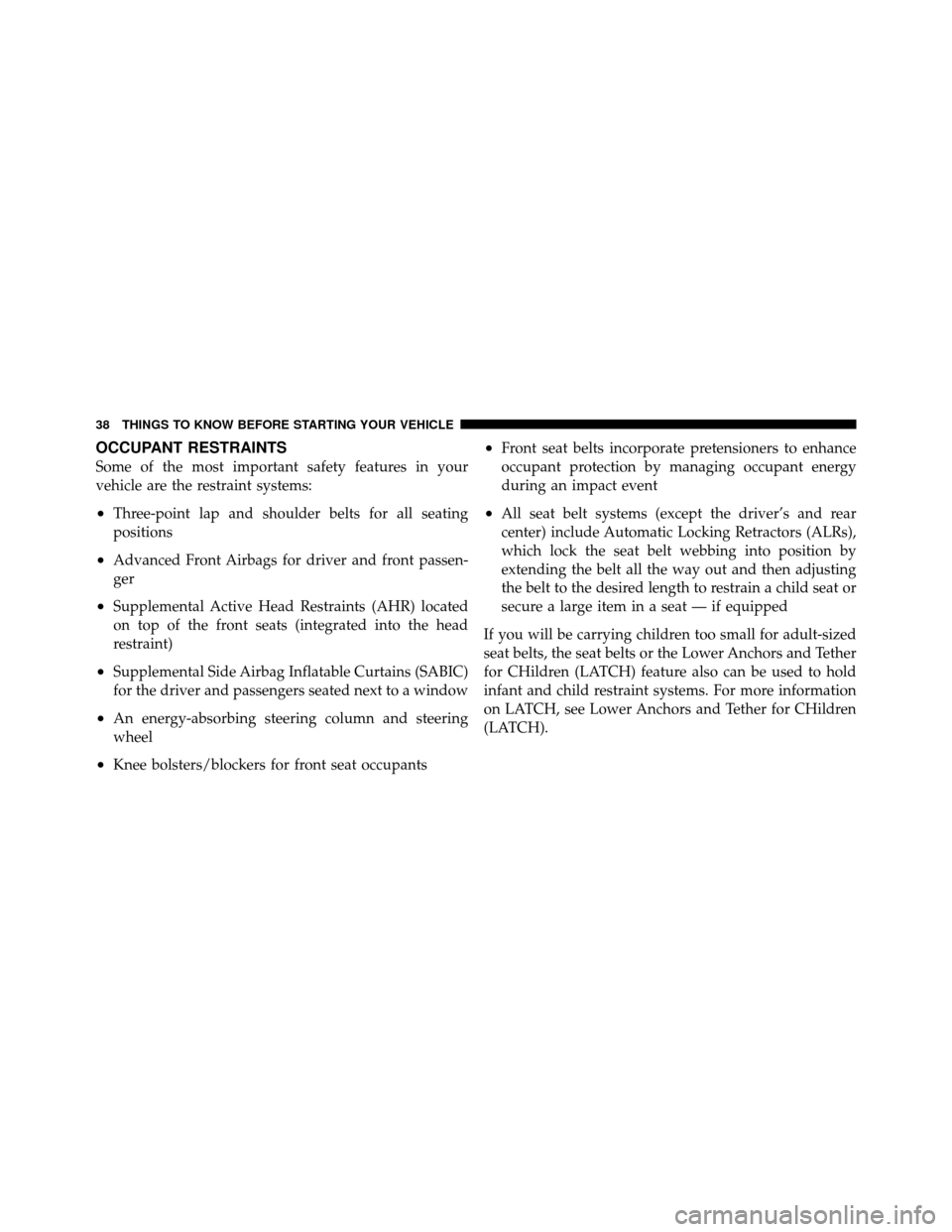
OCCUPANT RESTRAINTS
Some of the most important safety features in your
vehicle are the restraint systems:
•Three-point lap and shoulder belts for all seating
positions
•Advanced Front Airbags for driver and front passen-
ger
•Supplemental Active Head Restraints (AHR) located
on top of the front seats (integrated into the head
restraint)
•Supplemental Side Airbag Inflatable Curtains (SABIC)
for the driver and passengers seated next to a window
•An energy-absorbing steering column and steering
wheel
•Knee bolsters/blockers for front seat occupants
•Front seat belts incorporate pretensioners to enhance
occupant protection by managing occupant energy
during an impact event
•All seat belt systems (except the driver’s and rear
center) include Automatic Locking Retractors (ALRs),
which lock the seat belt webbing into position by
extending the belt all the way out and then adjusting
the belt to the desired length to restrain a child seat or
secure a large item in a seat — if equipped
If you will be carrying children too small for adult-sized
seat belts, the seat belts or the Lower Anchors and Tether
for CHildren (LATCH) feature also can be used to hold
infant and child restraint systems. For more information
on LATCH, see Lower Anchors and Tether for CHildren
(LATCH).
38 THINGS TO KNOW BEFORE STARTING YOUR VEHICLE
Page 40 of 498
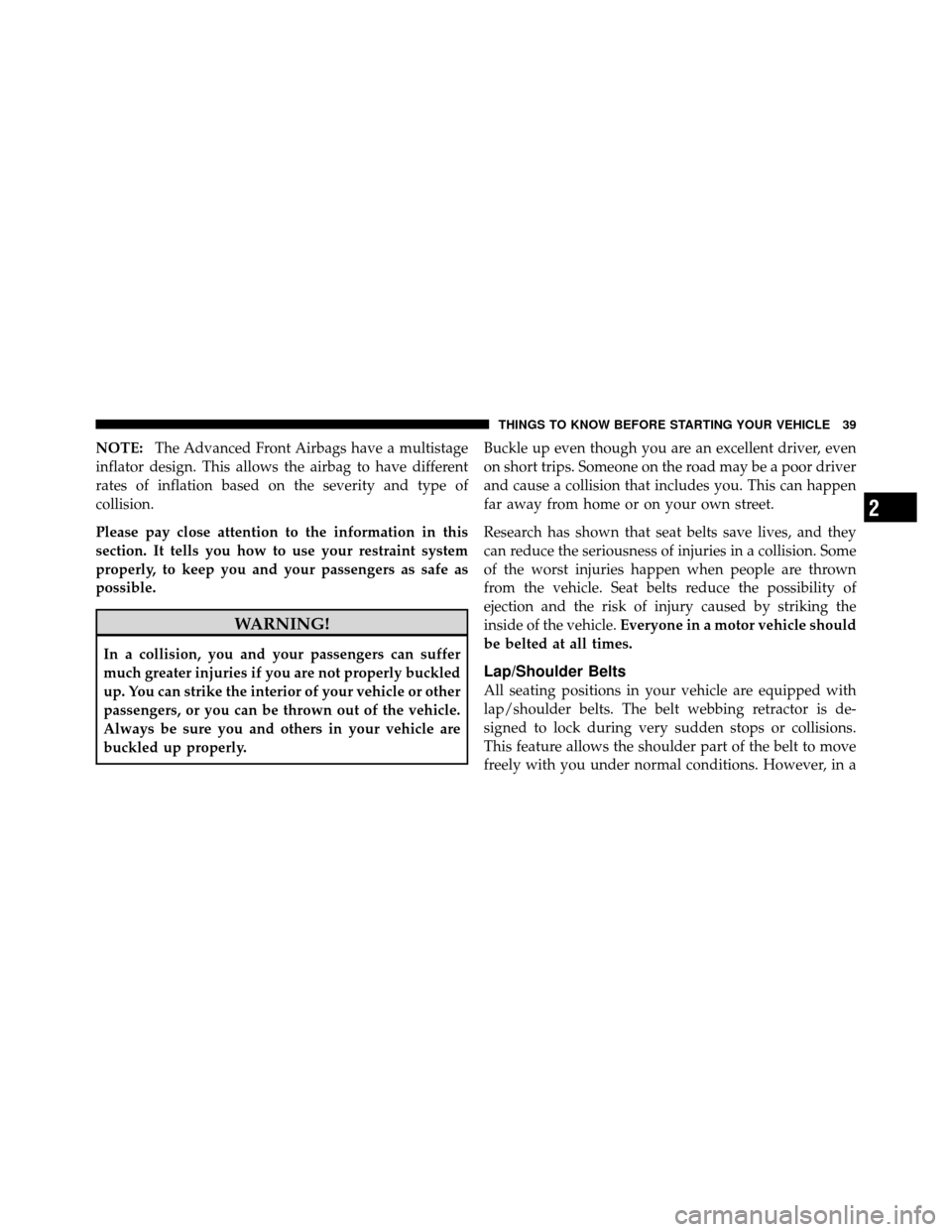
NOTE:The Advanced Front Airbags have a multistage
inflator design. This allows the airbag to have different
rates of inflation based on the severity and type of
collision.
Please pay close attention to the information in this
section. It tells you how to use your restraint system
properly, to keep you and your passengers as safe as
possible.
WARNING!
In a collision, you and your passengers can suffer
much greater injuries if you are not properly buckled
up. You can strike the interior of your vehicle or other
passengers, or you can be thrown out of the vehicle.
Always be sure you and others in your vehicle are
buckled up properly. Buckle up even though you are an excellent driver, even
on short trips. Someone on the road may be a poor driver
and cause a collision that includes you. This can happen
far away from home or on your own street.
Research has shown that seat belts save lives, and they
can reduce the seriousness of injuries in a collision. Some
of the worst injuries happen when people are thrown
from the vehicle. Seat belts reduce the possibility of
ejection and the risk of injury caused by striking the
inside of the vehicle.
Everyone in a motor vehicle should
be belted at all times.
Lap/Shoulder Belts
All seating positions in your vehicle are equipped with
lap/shoulder belts. The belt webbing retractor is de-
signed to lock during very sudden stops or collisions.
This feature allows the shoulder part of the belt to move
freely with you under normal conditions. However, in a
2
THINGS TO KNOW BEFORE STARTING YOUR VEHICLE 39